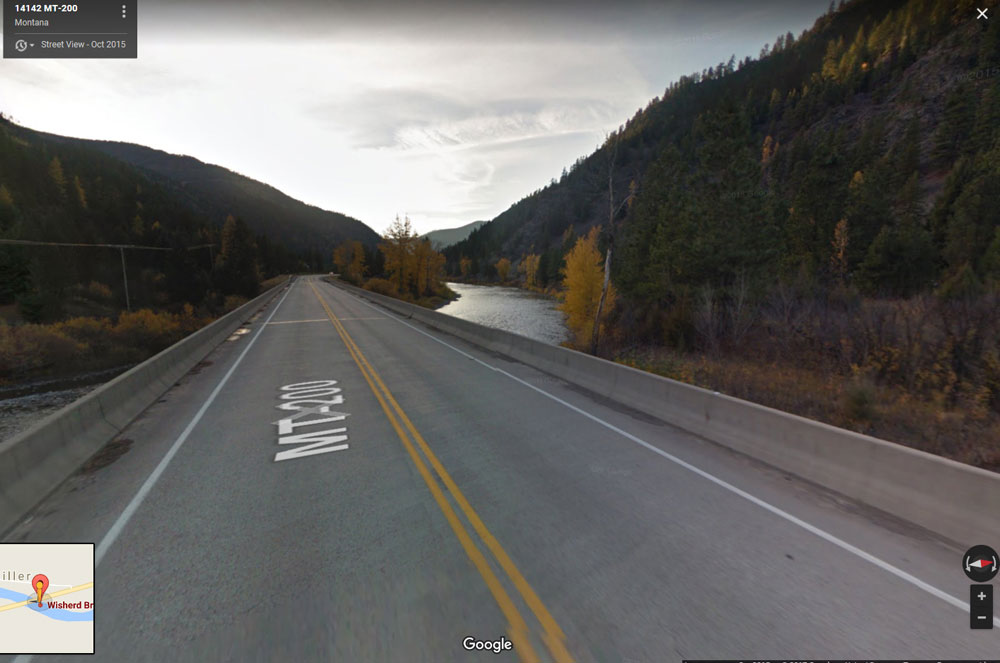 A modern Wisherd Bridge now crosses the Blackfoot By Bill Demmons with an Introduction by Minie Smith
A modern Wisherd Bridge now crosses the Blackfoot By Bill Demmons with an Introduction by Minie Smith
The old timers talk about them - and argue about the number of them: 4 or 5 or 6? Where exactly were they located on the Blackfoot? These questions came up at Tuesday morning coffee and the discussion was off. Summer visitor Bill Demmons spearheaded tracking down of the facts. Here is what he found. As to why they were all painted red? It appears that the Highway Department had an overabundance of red lead oxide paint which was preferred as it lasted longer than regular paint.
If you would like to see the maps that Bill obtained, stop by the Center! Here's the story from Bill: In the early 1900's, a dirt road ran along the Blackfoot River from Bonner to the Clearwater Junction area. Due to the many natural barriers bordering the river, five bridges were constructed over the 50-mile stretch, providing "detours" that bypassed the most severe of those barriers. The bridges were painted red, and were called "The Five Red Bridges on the Blackfoot".
The first bridge crossed the river a few miles upstream from Bonner, a detour onto Marco Flats on the north side of the river, necessitated by the Big Blue Slide, a long, steep, cascade of gravel, stone, and occasionally, trees, that spilled into the river. From Marco Flats, the old road ran along the north side of the river to a point across from the LaFray farmstead, where rocky outcrops required bridging back to more level ground on the south side. From there, the road ran upriver to a point across the river from the Wisherd farm, where steep cliffs on the south side forced the county to construct the third red bridge that carried traffic to the north side of the river again.
From Wisherd Creek, the road followed the Milwaukee's logging railroad to McNamara's Landing where large rocky outcrops upriver required another bridge, the fourth, taking the roadway back to the south bank, from where it crossed Bear Creek and ran along the foothills to the small ranching community, Potomac. From there, the road ran northeast through the Greenough Gap where the Anaconda Copper Mining Company had located a major logging operation.
The road then dropped into the wide valley occupied by the Morris Ranch. (Lindbergh, Paws Up). It crossed Elk Creek and then moved over to the Blackfoot River, following its course upstream, passing under the bench where the E-L Guest Ranch is located.
At the confluence of the Blackfoot and Clearwater Rivers, a fifth bridge was built to take the road away from rugged terrain on the south side of the Blackfoot, to the north side again, from where it ran to the area of today's Clearwater Junction. The road branched there, one fork trended due north to the Seeley Lake country, and the other fork took the road to Ovando.
As a footnote: Three hotels once catered to travelers on the road along the Blackfoot River. One was located in Potomac, one was built on the flat at McNamara's Landing (There was a saloon under the bridge at McNamara's Landing) and there was a "hotel" at the fifth red bridge, on the north side of the river.
The road with the five red bridges cut the travel time by auto between Missoula and Ovando to a few hours. Before the road and the bridges were in place, the trip by horse and wagon required several days travel in each direction.
The fifth red bridge at the confluence of the Blackfoot and the Clearwater Rivers is the only one of the five still intact and in use. It carries a fair amount of vehicular traffic, including many fishermen/women, including those from the E-L and Paws Up Guest ranches.
